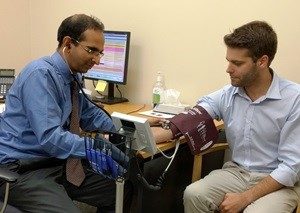
Medical researchers have confirmed that by taking an additional 3,500 steps and spending an extra 45 minutes on the move each week can reduce weight and lead to better wellbeing and long-term health.
South Australian researchers have drilled into the results of a popular online exercise program, showcasing the potential of using technology to reach millions of people to help reduce heart disease, diabetes and obesity rates around the world.
On average, participants lost just over 1.45kg and improved their health by increasing their amount of walking by more than 3,500 steps per day, reducing the time spent sitting by about 45 minutes per day and exercised nearly one additional day per week.
“In our connected world, we can use powerful technology tools to get people moving on a large scale, in a way that is not only attractive to consumers but affordable and accessible in even the most remote places on the planet,” says Flinders University research leader Associate Professor Anand Ganesan.
“Our study suggests that by using technology in a clever way, perhaps we, as a community, can devise solutions to tackle our leading health problems.”
Physical inactivity, sedentary lifestyles and obesity are massive global problems that affect high-, middle- and low-income countries alike, says Matthew Flinders Research Fellow Associate Professor Ganesan, who presented the findings at the American College of Cardiology’s 65th Annual Scientific Session in Chicago this week.
The research was based on a competition that uses technology to encourage and track physical activity which is proving effective at helping participants lose weight and exercise more in both developed and developing countries,
Using results from Stepathlon, a workplace fitness program used by thousands of people around Australia, the researchers analysed the records of more than 68,000 people in 64 countries who competed under the program to increase daily physical activity levels during the 100-day “virtual race.”
Cardiac disease is the #1 killer in Australia, while rising diabetes 2 and obesity rates are closely linked to physical inactivity and sedentary contemporary lifestyles.
In India, where Stepathlon was developed, there is one of the largest populations of diabetics in the world, with an estimated 60 million cases, many of whom undiagnosed.
“By reaching large numbers of people who can’t access the healthcare system we can really make a difference with low-cost initiatives like this,” Associate Professor Ganesan says.
“Even small companies in remote cities with limited medical specialists can make inroads into preventative action against these conditions by encouraging people to become more active, get fitter and more healthy in large-scale community initiatives.”
In Australia, government and corporate sector teams have joined annual Stepathlon events.
The workplace teams of five are given an inexpensive pedometer and encouraged to increase their daily step count through an interactive, multi-platform application that engages them with frequent emails, quizzes and social media communication. Each team competes with other teams around the world in a virtual race that culminates with prizes awarded in various categories at the end of the 100-day period.
“The idea is to increase physical activity and wellness, but in a fun and social way that builds on teamwork and camaraderie,” says Associate Professor Ganesan.
Data from annual Stepathlons held in 2012, 2013 and 2014 were used in the research team. Daily step count, number of days per week in which participants exercised, amount of weight lost and minutes per day spent sitting were measured.
More than 90 percent of participants were from low- and middle-income countries, and the results were consistent across countries of all income levels.
“To our knowledge, our study is the first to provide comparative data on the effectiveness of this kind of intervention in both the developed and developing world,” Associate Professor Ganesan says.
The results were also consistent in both men and women and were similar across all three years studied.
Run by a small tech company in India, the Stepathlon program costs about $62.50 per participant or $312.50 per team of five. The fees are usually paid by companies that invite their workers to enroll as part of a workplace wellness program.
Being physically active and maintaining a healthy weight are seen as important parts of a heart-healthy lifestyle. Obesity, physical inactivity and spending too much time sitting down have been associated with increased risk of cardiovascular disease, adverse cardiac events and death.
National Health and Medical Research Council of Australia-funded Associate Professor Ganesan and fellow researchers from the SA Health and Medical Research Institute, University of Adelaide and Stepathlon found the data had provided a scientific basis for promoting similar global mobile health (mHealth) solutions.
“Reproducible Impact of a Global Mobile Health (mHealth) Mass-Participation Physical Activity Intervention on Step Count, Sitting Behavior and Weight: The Stepathlon Cardiovascular Health Study,” by Anand Ganesan, Jennie Louise, Matthew Horsfall, Shane Bilsborough, Jeroen Hendriks, Joseph Selvanayagam and Derek Chew, has been published online in the Journal of the American College of Cardiology here.

